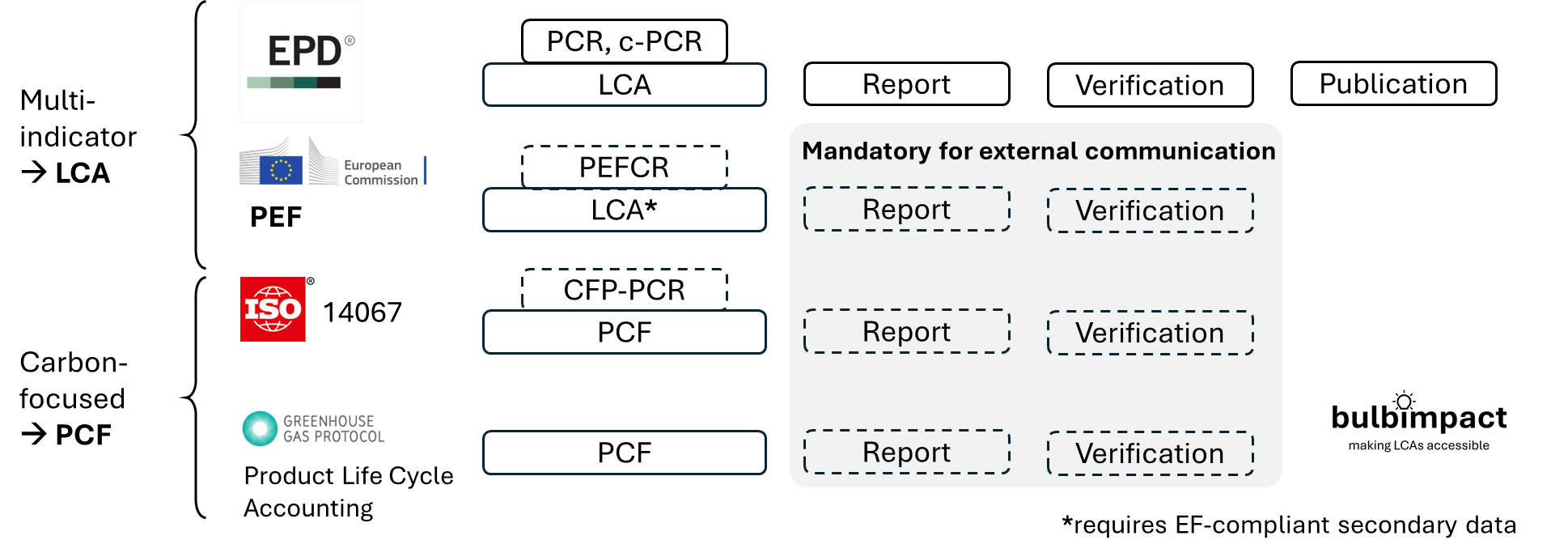Introduction to the Series
Life cycle assessment (LCA) and Product Carbon Footprint (PCF) methodologies have become fundamental tools in assessing environmental impacts across industries. Among the most prominent general LCA frameworks are the Product Environmental Footprint (PEF) and Environmental Product Declaration (EPD) while for PCF there are the ISO 14067 and GHG product standard. This article summarize the main difference of these methodologies, helping sustainability professionals navigate their complexities and applications. There are sector-specific LCA and PCF standards, but these are not covered in this series.
Read time: 5 minutes
Introduction to the Topic
The selection of an environmental assessment methodology depends on the specific objectives of a study, as well as regulatory and market expectations. Understanding the distinctions between PEF, EPD, ISO 14067, and the GHG Product Standard is essential for aligning with verification requirements, reporting obligations, and methodological constraints. This article summarizes the main differences between these frameworks, helping sustainability experts make informed decisions.
Goal of the Study
The choice of methodology is largely influenced by the intended application. Some assessments are influenced by emerging regulatory trends and evolving policy discussions. The proposed EU Green Claims Directive [1], for instance, has highlighted the potential role of PEF in substantiating environmental claims, though no formal requirement has been established. Similarly, certain industries, such as the construction sector, have developed strong market expectations around EPDs, aligning with procurement policies and voluntary certifications.
Preparing for potential regulatory developments and aligning with widely accepted methodologies can provide organizations with a strategic advantage in ensuring compliance and credibility in the future. Beyond regulatory compliance, some organizations pursue impact assessments for internal sustainability strategies, often as part of eco-design initiatives.
Methodologies also vary in their applicability for external communication. When making public environmental claims as part of a marketing campaign, third-party verification is often required to ensure credibility. In contrast, for internal performance tracking and product development, verification remains optional.
LCA vs. PCF: Understanding the Differences
A fundamental distinction exists between LCA-based and PCF-focused approaches. LCA methodologies, including PEF and EPD, provide a comprehensive assessment that encompasses multiple environmental indicators, such as carbon footprint, water consumption, resource depletion, and toxicity. These frameworks ensure a holistic sustainability evaluation, making them particularly relevant for industries where environmental trade-offs need to be carefully managed. Indeed, it is critical to prevent burden shifting, ensuring that efforts to reduce carbon emissions do not result in unintended environmental trade-offs.
PCF methodologies, represented by ISO 14067 and the GHG Product Standard, focus solely on carbon footprint quantification. These frameworks are well-suited for organizations that prioritize greenhouse gas reduction strategies or require a first step toward a broader sustainability assessment. A PCF can be derived from the allocation of the corporate carbon footprint to a product or from an LCA-based approach by isolating the carbon footprint results.
Product Category Rules and Data Requirements
The role of Product Category Rules (PCRs) differs across methodologies. EPDs require a PCR, and if one does not exist, a new rule must be developed to ensure consistency across assessments [2]. PEF follows a similar structure but treats PEF Category Rules (PEFCRs) as optional, though adherence to them is encouraged for comparability [3]. PCF standards such as ISO 14067 and the GHG Product Standard do not mandate PCRs, relying instead on general LCA guidelines [4,5].
Data quality is another critical factor influencing methodology selection. EPDs, ISO 14067 and GHG product standard require sustainability experts to evaluate secondary data sources on various criteria such as reliability and consistency [2,4,5]. PEF, however, enforces the use of EF-compliant datasets [6], which are maintained under a restricted-access system that may require either free or fee-based access. These distinctions in data requirements impact the feasibility, cost, and comparability of assessments.
Conclusion
Selecting the appropriate methodology requires a careful balance of regulatory requirements, market expectations, and data availability. While PCF methodologies offer a focused approach to carbon accounting, LCA-based frameworks provide a broader environmental perspective that is essential for a holistic sustainability assessment. Sustainability experts must consider the trade-offs between verification, data requirements, and methodological complexity when determining the most suitable framework.
Do you have any question ?
Please, feel free to reach out.
- https://eur-lex.europa.eu/legal-content/EN/TXT/?uri=COM:2023:0166:FIN
- https://www.environdec.com/home
- European Commission, Directorate-General for Environment. (2021). Commission Recommendation (EU) 2021/2279 of 15 December 2021 on the Use of the Environmental Footprint Methods to Measure and Communicate the Life Cycle Environmental Performance of Products and Organisations. http://data.europa.eu/eli/reco/2021/2279/oj
- https://www.iso.org/standard/71206.html
- https://ghgprotocol.org/product-standard
- https://eplca.jrc.ec.europa.eu/LCDN/contactListEF.html

Leave a Reply